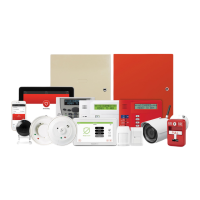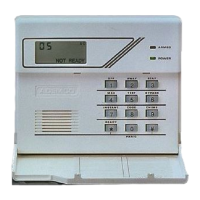


Do you have a question about the ADEMCO VISTA-100 and is the answer not in the manual?
Details the always-on fire protection feature and its associated alarms.
Explains the system's arming modes (STAY, AWAY, INSTANT, MAXIMUM) and zone bypassing.
Explains the system's remote access via phone for arming, disarming, and status updates.
Explains preset exit and entry delays for leaving or re-entering premises without triggering an alarm.
Details assignment of authority levels and security codes for system functions and user permissions.
Summarizes the six authority levels and their system function restrictions.
Details the procedure for adding new users, assigning codes, and setting authority levels.
Continues the user addition process, including multi-access, global arming, and partition access.
Details using the READY key to identify faulted zones before arming the system.
Explains using the BYPASS key to temporarily protect zones from alarming when armed.
Provides step-by-step instructions for bypassing individual zones.
Describes the feature to bypass all currently faulted zones automatically.
Explains arming the perimeter only, allowing interior movement and entry delay for the door.
Describes arming perimeter only with no entry delay, for immediate alarm on any perimeter breach.
Explains arming all protection for vacant premises, allowing exit delay but requiring disarming upon re-entry.
Details arming all protection with no entry delay, for maximum security during extended absences.
Explains using the OFF key to disarm the system, silence alarms, and clear trouble sounds.
Explains using key combinations to manually activate silent or audible emergency/fire functions.
Guides users through the weekly Walk Test mode to check each protection point.
Provides immediate actions for occupants upon discovering a fire emergency.
Details how to silence a fire alarm, clear the display, and address potential faults.
Explains how to conduct a fire drill test to activate bells and sounders.
Describes common trouble indicators (CHECK/TRBL) and their meanings, including "CALL SERVICE".
Explains indicators for power failure, AC loss, and low battery conditions.
Outlines NFPA-recommended steps for establishing and practicing fire escape plans.
Explains how the system detects low batteries in wireless sensors and their replacement.
Lists sounds, causes, and corresponding display messages for system events.
Offers guidance on troubleshooting telephone line issues and system disconnection.
Discusses system limitations regarding intruder bypass, device power, wireless signal blockage, and detector performance.
Covers limitations of sirens, telephone lines, component failure, and the importance of maintenance.
Details the warranty terms, obligations, limitations, and exclusions for the security equipment.
Details the always-on fire protection feature and its associated alarms.
Explains the system's arming modes (STAY, AWAY, INSTANT, MAXIMUM) and zone bypassing.
Explains the system's remote access via phone for arming, disarming, and status updates.
Explains preset exit and entry delays for leaving or re-entering premises without triggering an alarm.
Details assignment of authority levels and security codes for system functions and user permissions.
Summarizes the six authority levels and their system function restrictions.
Details the procedure for adding new users, assigning codes, and setting authority levels.
Continues the user addition process, including multi-access, global arming, and partition access.
Details using the READY key to identify faulted zones before arming the system.
Explains using the BYPASS key to temporarily protect zones from alarming when armed.
Provides step-by-step instructions for bypassing individual zones.
Describes the feature to bypass all currently faulted zones automatically.
Explains arming the perimeter only, allowing interior movement and entry delay for the door.
Describes arming perimeter only with no entry delay, for immediate alarm on any perimeter breach.
Explains arming all protection for vacant premises, allowing exit delay but requiring disarming upon re-entry.
Details arming all protection with no entry delay, for maximum security during extended absences.
Explains using the OFF key to disarm the system, silence alarms, and clear trouble sounds.
Explains using key combinations to manually activate silent or audible emergency/fire functions.
Guides users through the weekly Walk Test mode to check each protection point.
Provides immediate actions for occupants upon discovering a fire emergency.
Details how to silence a fire alarm, clear the display, and address potential faults.
Explains how to conduct a fire drill test to activate bells and sounders.
Describes common trouble indicators (CHECK/TRBL) and their meanings, including "CALL SERVICE".
Explains indicators for power failure, AC loss, and low battery conditions.
Outlines NFPA-recommended steps for establishing and practicing fire escape plans.
Explains how the system detects low batteries in wireless sensors and their replacement.
Lists sounds, causes, and corresponding display messages for system events.
Offers guidance on troubleshooting telephone line issues and system disconnection.
Discusses system limitations regarding intruder bypass, device power, wireless signal blockage, and detector performance.
Covers limitations of sirens, telephone lines, component failure, and the importance of maintenance.
Details the warranty terms, obligations, limitations, and exclusions for the security equipment.
| Brand | ADEMCO |
|---|---|
| Model | VISTA-100 |
| Category | Security System |
| Language | English |











